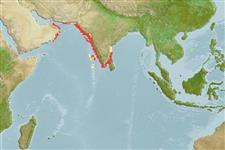Actinopterygii (peixes com raios nas barbatanas) >
Clupeiformes (Herrings) >
Clupeidae (Herrings, shads, sardines, menhadens) > Dorosomatinae
Etymology: Sardinella: Latin and Greek, sarda = sardine; name related to the island of Sardinia; diminutive (Ref. 45335). More on author: Valenciennes.
Ambiente / Clima / Intervalo
Ecologia
; marinhas; oceanódromos (Ref. 51243); intervalo de profundidade 20 - 200 m (Ref. 28016). Tropical, preferred 28°C (Ref. 107945); 25°N - 7°N, 57°E - 81°E (Ref. 54872)
Indian Ocean: northern and western parts only, Gulf of Aden, Gulf of Oman, but apparently not Red Sea or the Persian Gulf, eastward to southern part of India, on eastern coast to Andhra; possibly to the Andaman Islands. Thus, studies pertaining to this species from the Philippines or Indonesia probably refer to Sardinella lemuru.
Length at first maturity / Tamanho / Peso / Idade
Maturity: Lm 16.3 range ? - ? cm
Max length : 23.0 cm SL macho/indeterminado; (Ref. 188); common length : 20.0 cm SL macho/indeterminado; (Ref. 188); Peso máx. publicado: 200.00 g (Ref. 4883); Idade máx. registada: 3 anos (Ref. 3689)
Espinhos dorsais (total): 0; Raios dorsais (total): 13-21; Espinhos anais 0; Raios anais : 12 - 23; Vértebras: 45 - 49. Body sub-cylindrical; a faint golden spot behind gill opening, followed by a faint golden mid-lateral line; a distinct black spot at hind border of gill cover (absence of pigment). Distinguished from all clupeids in the northern Indian Ocean by its pelvic fin ray count of i 8; from S. neglecta and S. lemuru by its longer head and more lower gill rakers. No prominent keel. See also Refs. 3683, 818 and 393 .
Coastal pelagic (Ref. 68964). Forms schools in coastal waters and strongly migratory. Feeds mainly on phytoplankton (especially diatoms) and small crustaceans (Ref. 30573). Breeds once a year off western coasts of India when temperatures and salinity are low during the southwest monsoon months. Spawning peaks in August-September. Occurs at temperatures of 22.0-28.0 °C (Ref. 3689). Marketed fresh, dried and dried-salted. Also sold smoked and canned (Ref. 9987). Also made into fish meal and fish balls.
Spawning usually takes place at night (Ref. 810).
Whitehead, P.J.P., 1985. FAO Species Catalogue. Vol. 7. Clupeoid fishes of the world (suborder Clupeioidei). An annotated and illustrated catalogue of the herrings, sardines, pilchards, sprats, shads, anchovies and wolf-herrings. FAO Fish. Synop. 125(7/1):1-303. Rome: FAO. (Ref. 188)
Status na Lista Vermelha da IUCN (Ref. 115185)
CITES (Ref. 94142)
Not Evaluated
Perigo para os humanos
Harmless
Uso pelos humanos
Pescarias: altamente comercial
Mais informação
ColaboradoresFotosStamps, CoinsSonsCiguateraVelocidadeTipo de nataçãoÁrea branquialOtólitosCérebrosVisão
Ferramentas
Relatórios especiais
Baixar XML
Fontes da internet
